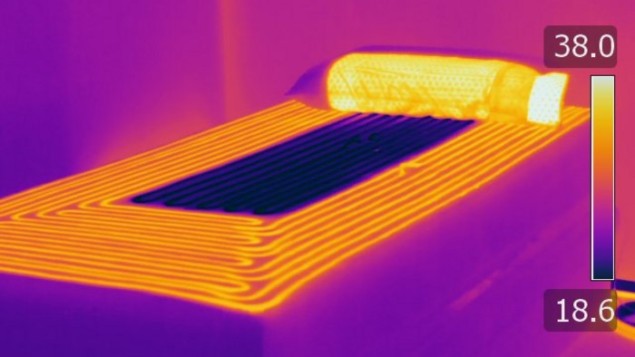Hot and cold mattress for a better sleep, video referees struggle with offside decisions
22 Jul 2022 Hamish Johnston

Today it is cool and raining here in Bristol, but earlier this week the temperature reached 36.9 °C in the city – which is extremely hot for this part of the world. Like many Bristolians, I found it difficult to sleep and I tossed and turned all night.
If only I had access to a new mattress and pillow system that has been developed by bioengineers at the University of Texas at Austin. Described in The Journal of Sleep Research, the system monitors the temperature of different parts of the body including the neck, hands and feet. It then gently adjusts the temperature at different points on the body to encourage blood flow from the body’s core to its extremities. The idea being that a cooling core encourages one to doze off faster and enjoy a better sleep.
The team has patented the technology and is seeking commercial partnerships with mattress manufacturers.
Tricky decisions
The offside rule in association football/soccer can be difficult for fans to understand – and sometimes tricky for referees to apply. The rule prevents players from hanging around the opposition’s goal waiting for a passed ball, which would make for a boring game.
Deciding whether an offside offence occurs involves observing the location of the ball as well as the locations and actions of several players. Because a play can look different from different angles, referees’ judgements are often hotly contested.
Many football leagues now use video assistant referee (VAR) technologies to give the referee in charge more information. This involves stopping play and having an assistant referee review video taken from different angles.
Motion capture systems
Now Pooya Soltani at the University of Bath’s Centre for Analysis of Motion, Entertainment Research and Applications has used optical motion capture systems to assess the accuracy of VAR systems.
The UK-based researcher filmed a football player receiving the ball from a teammate, viewed from different camera angles, whilst recording the 3D positions of the ball and players using optical motion capture cameras.
Participants viewing the clips were asked to determine the exact moment of the kick and judge whether the ball receiver was offside. The study found that, on average, the participants thought the ball was kicked 132 ms later it actually was. It also found that participants were more accurate in their judgements when viewing the pitch at certain angles.
“VAR is really useful in helping referees make accurate decisions, but this study has shown it has definite limitations,” says Soltani. He presented his findings at the 40th Conference of the International Society of Biomechanics in Sports, which is currently being held in Liverpool.

Hamish Johnston is an online editor of Physics World
FROM PHYSICSWORLD.CCOM 24/7/2022
Δεν υπάρχουν σχόλια:
Δημοσίευση σχολίου